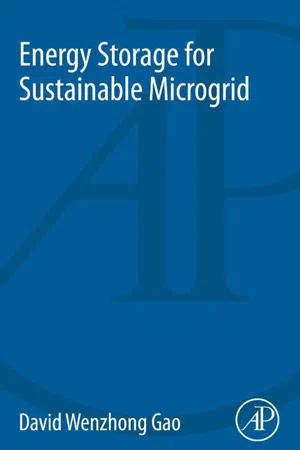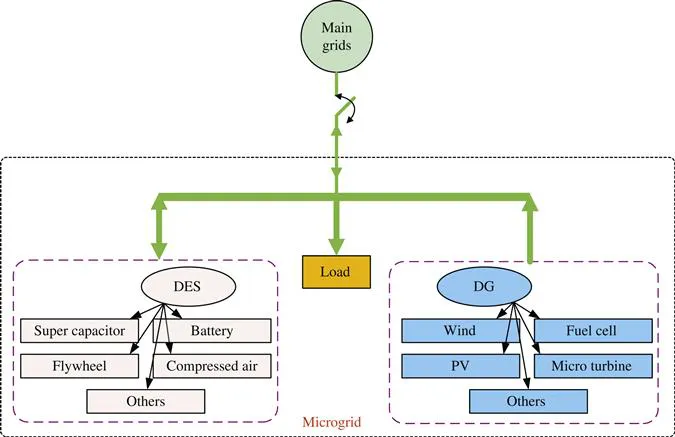
eBook - ePub
Energy Storage for Sustainable Microgrid
David Wenzhong Gao
This is a test
- 152 pagine
- English
- ePUB (disponibile sull'app)
- Disponibile su iOS e Android
eBook - ePub
Energy Storage for Sustainable Microgrid
David Wenzhong Gao
Dettagli del libro
Anteprima del libro
Indice dei contenuti
Citazioni
Informazioni sul libro
Energy Storage for Sustainable Microgrid addresses theissues related to modelling, operation and control, steady-state and dynamic analysis of microgrids with ESS. This book discusses major electricity storage technologies in depth along with their efficiency, lifetime cycles, environmental benefits and capacity, so that readers can envisage which type of storage technology is best for a particular microgrid application. This book offers solutions to numerous difficulties such as choosing the right ESS for the particular microgrid application, proper sizing of ESS for microgrid, as well as design of ESS control systems for proper interfacing with the microgrid.
- Explanations for major power electronic converters/technology required to achieve the desired interfacing
- Case studies on the major impacts of energy storage on microgrid
- Detailed solutions for choosing the right ESS for particular microgrid applications
- Valuable economics chapter to help evaluate entire systems
Domande frequenti
Come faccio ad annullare l'abbonamento?
È semplicissimo: basta accedere alla sezione Account nelle Impostazioni e cliccare su "Annulla abbonamento". Dopo la cancellazione, l'abbonamento rimarrà attivo per il periodo rimanente già pagato. Per maggiori informazioni, clicca qui
È possibile scaricare libri? Se sì, come?
Al momento è possibile scaricare tramite l'app tutti i nostri libri ePub mobile-friendly. Anche la maggior parte dei nostri PDF è scaricabile e stiamo lavorando per rendere disponibile quanto prima il download di tutti gli altri file. Per maggiori informazioni, clicca qui
Che differenza c'è tra i piani?
Entrambi i piani ti danno accesso illimitato alla libreria e a tutte le funzionalità di Perlego. Le uniche differenze sono il prezzo e il periodo di abbonamento: con il piano annuale risparmierai circa il 30% rispetto a 12 rate con quello mensile.
Cos'è Perlego?
Perlego è un servizio di abbonamento a testi accademici, che ti permette di accedere a un'intera libreria online a un prezzo inferiore rispetto a quello che pagheresti per acquistare un singolo libro al mese. Con oltre 1 milione di testi suddivisi in più di 1.000 categorie, troverai sicuramente ciò che fa per te! Per maggiori informazioni, clicca qui.
Perlego supporta la sintesi vocale?
Cerca l'icona Sintesi vocale nel prossimo libro che leggerai per verificare se è possibile riprodurre l'audio. Questo strumento permette di leggere il testo a voce alta, evidenziandolo man mano che la lettura procede. Puoi aumentare o diminuire la velocità della sintesi vocale, oppure sospendere la riproduzione. Per maggiori informazioni, clicca qui.
Energy Storage for Sustainable Microgrid è disponibile online in formato PDF/ePub?
Sì, puoi accedere a Energy Storage for Sustainable Microgrid di David Wenzhong Gao in formato PDF e/o ePub, così come ad altri libri molto apprezzati nelle sezioni relative a Technologie et ingénierie e Ressources d'alimentation. Scopri oltre 1 milione di libri disponibili nel nostro catalogo.
Informazioni
Argomento
Technologie et ingénierieCategoria
Ressources d'alimentationChapter 1
Basic Concepts and Control Architecture of Microgrids
This chapter discusses the basic concepts and control structures of microgrids. Nowadays, distributed generation technology is becoming increasingly mature, and is deployed as active distribution networks working cooperatively with conventional power grids. In addition, the issues of exhaustible natural resources, fluctuating fossil fuel prices and the security of electricity have encouraged governments around the world to hold positive attitudes toward the development of emerging microgrids. Future microgrids will allow high renewable penetration and become building blocks of smart grids thanks to advanced communication and information technology. As the underlying scientific and engineering research questions are being answered, there is no doubt that microgrids will play an extremely important role in future electric power and energy systems.
Keywords
Centralized control; Control architectures; Decentralized control; Energy storage system; Microgrid concepts; Microgrid protection; Renewable energy resources; State estimation
1.1 Introduction
This chapter discusses the basic concepts and control structures of microgrids. Nowadays, distributed generation technology is becoming more and more mature, and is deployed as key elements of active distribution network working cooperatively with conventional power grids. In addition, the issues of exhaustible natural resources, fluctuating fossil fuel prices and security of electricity have encouraged governments around the world to hold positive attitudes toward the development of emerging microgrids. Future microgrids will allow high renewable penetration and become building blocks of smart grids thanks to advanced communication and information technology. As the underlying scientific and engineering research questions are being answered, there is no doubt that microgrids will play an extremely important role in future electric power and energy systems.
1.1.1 Concepts of Microgrids
Power generation in the traditional power grid is highly centralized, with power and energy flowing unidirectionally from large synchronous generators through a transmission/distribution network to end-users. However, the technological issues associated with traditional electric utilities, as well as the environmental problems caused by the combustion of fossil fuels, have stimulated research and development into new power system technologies. With the emergence of distributed energy resource (DER) units, e.g., wind, photovoltaic (PV), battery, biomass, micro-turbine, fuel cell, etc., microgrid technologies have attracted increasing attention as an effective means of integrating such DER units into power systems. However, there is no clear definition of a microgrid, and the concept varies in different countries and regions. Based on the European Technology Platform of Smart Grids [1], a microgrid is a platform that facilitates the integration of distributed generators (DG), energy storage systems (ESS) and loads to ensure that the power grid can supply sustainable, price-competitive and reliable electricity. Figure 1.1 shows a typical microgrid structure, comprising DGs, such as combined heat and power unit (CHP), microturbines, PV systems, wind power systems, fuel cells; a distributed energy storage (DES) facility such as battery banks, super-capacitors, flywheels, electric vehicles; flexible loads and control devices.

Microgrids can be classified as AC and DC types. AC microgrids can be integrated into existing AC power grid, but they require quite complicated control strategies for the synchronization process in order to preserve the stability of the system. On the other hand, DC microgrids have better short circuit protection and significantly improved efficiency. Furthermore, some synchronous units (e.g., diesel generators) and some non-synchronous units (e.g., micro-turbine machines) are usually connected in the same microgrid system. As the penetration level of more DC loads (especially Plug-in Hybrid Electric Vehicles) increases, hybrid AC/DC synchronous/non-synchronous microgrids via multiple bi-directional converters will become increasingly attractive. Figure 1.2 shows a typical system structure for a hybrid AC/DC microgrid that contains power electronic interfaces and multiple DER units.

Although many types of DG units are more sustainable, a high level penetration of renewable energy resources (e.g., wind, PV) in microgrids can make maintaining grid stability and delivering reliable power challenging due to intermittency and fluctuation issues. In such cases, a DES can play an essential role in improving stability, strengthening reliability, and ensuring security. Not only can DES units be used for smoothing the fluctuations from the output of DG units, but they ...